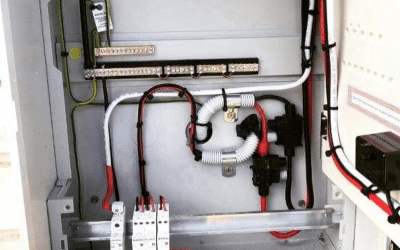In recent years, the global push for reducing carbon footprints has become a central theme in environmental conservation efforts. This movement is driven by the urgent need to address climate change and its far-reaching impacts on ecosystems, weather patterns, and global temperatures. Central to this endeavour is the concept of energy efficiency – a principle that not only promises to lower greenhouse gas emissions but also offers a pathway to a more sustainable and eco-friendly lifestyle.
Energy efficiency refers to the practice of using less energy to perform the same tasks, thereby reducing energy waste and, consequently, the amount of carbon dioxide and other harmful gases released into the atmosphere. This concept is pivotal in the context of carbon footprint reduction as it touches on virtually every aspect of daily life, from how we light and heat our homes to the way industries operate and how our cities are designed.
The importance of energy efficiency cannot be overstated. It represents a practical and accessible means for individuals, businesses, and governments to contribute to a significant reduction in global carbon emissions. By adopting more energy-efficient technologies and practices, such as switching from incandescent bulbs to ENERGY STAR-qualified CFL bulbs, we not only help mitigate the effects of climate change but also pave the way for a future that is both environmentally sustainable and economically viable. This switch alone could significantly reduce the electricity used for lighting by 75%, showcasing the direct environmental impacts of specific energy-efficient actions.
Understanding Your Carbon Footprint
A carbon footprint is a measure of the total amount of greenhouse gases, including carbon dioxide and methane, that are emitted directly or indirectly by activities of an individual, organisation, event, or product. It is usually expressed in equivalent tons of carbon dioxide (CO2e) and encompasses all sources of these gases, from the energy used in homes and for transportation, to the production and disposal of the goods and food we consume. Understanding one’s carbon footprint is critical as it quantifies the impact of personal or organisational activities on global warming, offering a clear perspective on one’s contribution to climate change.
Several factors contribute to an individual’s carbon footprint, making it a complex interplay of various elements. These include:
- Energy consumption: This is often the largest component of a carbon footprint, encompassing the electricity and heating used in homes, which depends on the sources of energy production, efficiency of appliances, and personal usage patterns.
- Transportation: The choice of transportation mode, frequency of travel, type of vehicle, and fuel efficiency significantly influence an individual’s emissions. Air travel, in particular, is a major contributor to carbon footprints.
- Diet: The production, processing, and transportation of food all contribute to greenhouse gas emissions. Diets rich in meat and dairy products typically have higher carbon footprints due to the methane produced by livestock.
- Goods and services: The production and disposal of consumer goods, including clothing, electronics, and household items, contribute to carbon emissions through the energy used in manufacturing processes and waste management.
By understanding these factors, individuals can identify areas where changes can lead to significant reductions in their carbon footprint. Awareness is the first step towards adopting a more sustainable lifestyle, and it empowers people to make informed decisions that not only benefit themselves but also have a positive impact on the planet.
The Role of Energy Efficiency
Energy efficiency plays a critical role in the global effort to reduce carbon footprints and combat climate change. At its core, energy efficiency involves using less energy to achieve the same level of output or activity, thereby minimising waste and reducing the demand for energy production. This is achieved through various means, including the adoption of more efficient technologies, improvements in building designs, and changes in behaviours or practices that lead to lower energy consumption.
The reduction of greenhouse gas emissions through energy efficiency is both direct and significant. By consuming less energy, we decrease the need for energy production, which is often reliant on fossil fuels like coal, oil, and natural gas. These fuels are the primary sources of carbon dioxide and other greenhouse gases that contribute to global warming. Therefore, enhancing energy efficiency in homes, businesses, and transportation can substantially lower the amount of these harmful emissions released into the atmosphere.
Benefits of Energy Efficiency
Environmental Benefits:
The environmental advantages of energy efficiency are profound and varied. By reducing energy demand, we not only cut down on greenhouse gas emissions but also lessen air and water pollution associated with energy production. This contributes to healthier ecosystems and a more sustainable planet. Moreover, energy efficiency can help mitigate the need for new energy infrastructure, preserving natural landscapes and biodiversity.
Economic Advantages for Households and Businesses:
Energy efficiency offers significant economic benefits by lowering utility bills for households and operational costs for businesses. Investments in energy-efficient appliances, lighting, and heating and cooling systems can yield substantial savings over time, offsetting initial expenses. For businesses, these savings can improve competitiveness and profitability, while households can enjoy a higher disposable income.
Enhanced Energy Security and Reduced Dependency:
Improving energy efficiency enhances national energy security by reducing overall energy demand. This diminishes dependency on imported fuels, making countries less vulnerable to supply disruptions and volatile fuel prices. Furthermore, by fostering a more resilient and diversified energy system, energy efficiency contributes to a more stable and secure energy supply framework.
The role of energy efficiency in reducing greenhouse gas emissions and fostering a sustainable future cannot be overstated. It is a pivotal element in the global strategy to combat climate change, offering a pathway to achieving environmental goals while also providing economic and security benefits. The adoption of energy-efficient practices and technologies is a critical step towards a more sustainable and prosperous future for all.
Practical Ways to Reduce Your Carbon Footprint
Reducing your carbon footprint is a crucial step towards mitigating climate change, and there are many practical ways to achieve this goal. By focusing on energy efficiency, adopting sustainable transportation methods, and making informed lifestyle choices, individuals can make a significant impact.
- Energy-efficient appliances and lighting: Opting for appliances with high energy efficiency ratings, such as those certified by energy-saving programs, can drastically reduce household energy consumption. Similarly, replacing incandescent bulbs with LED lighting can lower energy use and extend the lifespan of lighting fixtures.
- Home insulation and energy management: Proper insulation in walls, roofs, and floors helps retain heat during winter and cool air during summer, reducing the need for heating and cooling. Smart thermostats and energy management systems can further optimise energy use, adapting to your habits and preferences for maximum efficiency.
- Sustainable transportation methods: Choosing public transportation, carpooling, biking, or walking over driving alone can significantly cut down on greenhouse gas emissions. For those who drive, considering a hybrid or electric vehicle can also reduce fuel consumption and emissions.
Reducing Water Use and Its Impact
- Water conservation practices: Simple actions like fixing leaks, using water-efficient fixtures, and adopting water-smart gardening techniques can significantly reduce water usage.
- The link between water use and energy consumption: Water treatment and distribution require substantial amounts of energy. By conserving water, we indirectly reduce energy consumption and the associated carbon emissions, illustrating the interconnectedness of resource use.
The Impact of Diet on Your Carbon Footprint
- Comparing the carbon footprints of different diets: Diets high in red meat and dairy products tend to have higher carbon footprints due to the methane emissions from livestock and the energy-intensive nature of meat production. Plant-based diets are generally more carbon-efficient.
- Tips for adopting a low-carbon diet: Incorporating more plant-based meals, reducing meat consumption, choosing locally sourced foods, and minimising food waste are effective strategies for reducing dietary carbon footprints.
Lifestyle Changes to Shrink Your Carbon Footprint
- Everyday habits that make a difference: Small changes, such as reducing energy consumption, recycling, and choosing sustainable products, can collectively make a big impact.
- The importance of sustainable consumption: Being mindful of our consumption patterns and opting for products that are durable, repairable, and sustainably sourced can significantly reduce our carbon footprint. This includes everything from clothing to electronics, emphasising the need for a shift towards more responsible consumption habits.
By adopting these practical measures, individuals can actively contribute to reducing their carbon footprint, paving the way for a more sustainable future. Each action, no matter how small, adds up to a significant impact when embraced by communities worldwide, highlighting the power of collective effort in addressing climate change.
Reducing Carbon Footprint at Home
Reducing your carbon footprint at home involves a combination of assessing energy use, implementing efficiency measures, and exploring renewable energy options. This approach not only contributes to environmental conservation but also offers financial savings in the long run.
- Energy audits and where to focus your efforts: Conducting a home energy audit is a crucial first step in identifying areas where energy efficiency can be improved. This assessment can reveal energy leaks, inefficient appliances, and other issues that contribute to higher energy consumption. Focusing efforts on sealing leaks, adding insulation, and upgrading to energy-efficient appliances can have a significant impact on reducing your home’s carbon footprint.
- Renewable energy options for homeowners: Transitioning to renewable energy sources is a powerful strategy for reducing greenhouse gas emissions. Solar panels are the most accessible option for many homeowners, offering a way to generate clean electricity on-site. Other options include wind turbines, where feasible, and purchasing green power from your utility company, which helps support renewable energy development.
Smart Technologies and Home Automation
- How technology can assist in reducing energy use: Smart technologies and home automation systems play a pivotal role in optimising energy use and reducing waste. These systems can learn your habits and adjust heating, cooling, lighting, and other energy-consuming activities to ensure they are only used when needed, maximising efficiency.
- Examples of smart home devices that help save energy:
- Smart thermostats: These devices can adjust the temperature based on your schedule and preferences, reducing heating and cooling costs.
- Smart lighting systems: LED bulbs paired with smart lighting controls can turn lights off automatically when rooms are unoccupied and adjust brightness based on the time of day.
- Energy monitors: These systems provide real-time feedback on energy consumption, helping identify areas for improvement and tracking the impact of energy-saving measures.
- Smart plugs and power strips: These can remotely control appliances, ensuring they are turned off when not in use to avoid “vampire power” consumption.
Adopting smart technologies and making strategic upgrades to your home can significantly reduce your carbon footprint. By focusing on energy efficiency and integrating renewable energy sources, homeowners can contribute to a more sustainable future while enjoying the benefits of a more comfortable and cost-effective living environment.
Transportation’s Role in Carbon Footprints
Transportation is a major contributor to global carbon emissions, with different modes of transport varying significantly in their environmental impact. Understanding these differences and making informed choices about how we travel can significantly reduce our carbon footprints.
- Comparing the emissions from different modes of transport: Personal vehicles, especially those powered by gasoline or diesel, are among the highest contributors to carbon emissions in the transportation sector. Air travel also ranks high due to the substantial amounts of fuel burned per passenger. In contrast, public transportation systems like buses and trains generally have a lower carbon footprint per passenger mile. Cycling and walking produce no emissions at all, making them the most environmentally friendly modes of transportation.
- Benefits of electric vehicles and public transport: Electric vehicles (EVs) offer a promising alternative to traditional combustion engines, significantly reducing emissions, especially when charged with electricity from renewable sources. The widespread adoption of EVs, coupled with improvements in battery technology and charging infrastructure, is crucial for reducing emissions from personal transportation. Public transport, by efficiently moving large numbers of people, reduces the overall number of vehicles on the road, decreasing traffic congestion and lowering emissions per capita. Investing in and choosing public transportation not only contributes to a reduction in individual carbon footprints but also supports the development of more sustainable urban infrastructures.
Adopting electric vehicles and utilising public transportation are key strategies for reducing transportation-related carbon emissions. By making conscious choices about how we travel, individuals can contribute to a significant reduction in global greenhouse gas emissions, moving us closer to achieving international climate goals and fostering a healthier planet for future generations.
Overcoming Challenges in Carbon Footprint Tracking
Tracking and reducing one’s carbon footprint is a critical step towards mitigating climate change, yet it comes with its own set of challenges. Fortunately, advancements in technology and the development of user-friendly tools have made it easier to monitor and manage our environmental impact.
- Tools and apps for monitoring your carbon footprint: A variety of digital tools and applications now exist to help individuals and businesses accurately track their carbon emissions. These tools often incorporate various aspects of daily life, including transportation, home energy use, diet, and shopping habits, providing a comprehensive overview of one’s carbon footprint. Popular apps offer features like tracking, tips for reduction, and even linking users to carbon offsetting opportunities. These digital solutions democratise the process of carbon management, making it accessible to a wider audience.
- Addressing the accuracy and usability of carbon calculators: While carbon calculators offer a valuable resource for understanding and reducing one’s environmental impact, their effectiveness can be limited by the accuracy of the data they use and their ease of use. To address these challenges, developers are continually refining their algorithms and incorporating more detailed and region-specific data to provide more accurate estimates. Usability enhancements are also a focus, with efforts to simplify data entry processes and make these tools more intuitive and engaging for users.
The ongoing development of carbon tracking tools reflects a growing recognition of the importance of individual actions in the fight against climate change. By leveraging these tools to monitor and reduce our carbon footprints, we can make informed decisions that contribute to a more sustainable future. As these technologies continue to evolve, they promise to become an even more integral part of our daily efforts to protect the environment.
Future of Energy Efficiency and Carbon Reduction
The future of energy efficiency and carbon reduction is poised at an exciting juncture, with emerging technologies, policy advancements, and societal shifts converging to accelerate progress towards a more sustainable future. As we move forward, these elements will play critical roles in shaping our environmental impact and our ability to mitigate climate change effectively.
- Emerging Technologies and Innovations: Cutting-edge technologies are set to revolutionise energy efficiency across various sectors. Innovations such as ultra-efficient photovoltaic cells, battery storage advancements, and smart grid technologies promise to enhance the integration and effectiveness of renewable energy sources. Additionally, developments in materials science, such as phase-changing materials for better insulation and aerogels for super-insulating windows, are expected to significantly reduce energy demands in buildings. Artificial intelligence and machine learning are also becoming instrumental in optimising energy use in real-time across transportation, industrial processes, and home energy management systems.
- Policy and Societal Shifts Supporting Carbon Footprint Reduction: On the policy front, governments worldwide are implementing more stringent regulations on emissions, setting ambitious renewable energy targets, and providing incentives for energy efficiency improvements. These policies are crucial for creating a supportive environment for the adoption of sustainable practices and technologies. At the same time, there is a noticeable shift in societal attitudes towards sustainability. Increased awareness and concern about climate change are driving consumer demand for green products and services, encouraging companies to adopt more sustainable practices. Furthermore, grassroots movements and community-led initiatives are increasingly influential in promoting local actions and policy changes for environmental sustainability.
The future of energy efficiency and carbon reduction is not just about technological innovation; it is also about how society chooses to adopt and support these changes. By continuing to develop and deploy new technologies, while also fostering a cultural shift towards sustainability and backing this up with supportive policies, we can make significant strides in reducing our carbon footprints. The collective effort of individuals, businesses, and governments will be paramount in navigating the challenges ahead and securing a sustainable, low-carbon future.
Engaging Communities in Carbon Footprint Reduction
Engaging communities in reducing their carbon footprint is crucial for amplifying the impact of individual actions and fostering a collective response to climate change. Through education, awareness campaigns, and community projects, we can build a more sustainable future together.
- Role of Education and Awareness Campaigns: Education is pivotal in empowering individuals with the knowledge to make informed decisions about their carbon footprint. Awareness campaigns are vital for highlighting the urgency of climate change and the practical steps communities can take to mitigate their impact. These campaigns can take various forms, from workshops and seminars to social media initiatives, all aimed at disseminating information on energy efficiency, sustainable living, and the importance of reducing carbon emissions. By making this information accessible and engaging, communities can be motivated to adopt more sustainable practices.
- Community Projects and Collective Action: Community projects offer a tangible way for individuals to come together and take collective action towards reducing their carbon footprint. Examples include community solar projects, which allow residents to collectively invest in solar energy; urban greening initiatives, such as tree planting and community gardens, which help absorb CO2; and car-sharing programs to reduce individual vehicle use. These projects not only contribute to carbon reduction but also strengthen community bonds and create more livable, sustainable neighbourhoods.
Furthermore, collective action can extend to advocacy and lobbying for local policy changes that support sustainability. Communities can advocate for the adoption of renewable energy, improved public transportation, and the development of green infrastructure, ensuring that local policies align to reduce carbon footprints.
By engaging in education, awareness campaigns, and community projects, individuals can play a direct role in climate action. These efforts not only contribute to the immediate goal of reducing carbon emissions but also foster a culture of sustainability that can inspire further action and influence broader societal change.
How Businesses Are Contributing
In the fight against climate change, businesses play a crucial role through corporate responsibility and sustainability initiatives. Many companies are now recognising the importance of reducing their carbon footprint, not just as a moral imperative but also as a strategic business decision that can lead to long-term benefits.
- Corporate Responsibility and Sustainability Initiatives: Across industries, businesses are implementing sustainability initiatives that focus on reducing energy consumption, minimising waste, and sourcing materials responsibly. This includes adopting energy-efficient practices, investing in renewable energy, and redesigning products and processes to be more environmentally friendly. Corporate responsibility also extends to supply chain management, where companies are working to ensure that their suppliers adhere to sustainable practices, thereby reducing the carbon footprint of their products from production to delivery.
- Examples of Businesses Significantly Reducing Their Emissions:
- A leading global technology company has committed to becoming carbon neutral across its entire supply chain and product lifecycle by 2030. This includes transitioning to 100% renewable energy for all its operations and investing in reforestation projects.
- A major retailer has launched a sustainability program aimed at eliminating all greenhouse gas emissions from its operations by 2040, without relying on carbon offsets. Key strategies include electrifying its vehicle fleet, incorporating energy-efficient technologies in its stores, and sourcing 100% renewable electricity.
- A multinational beverage company has set ambitious targets to reduce carbon emissions by 25% across its entire value chain by 2030. Efforts include improving the energy efficiency of its manufacturing processes, investing in sustainable packaging, and partnering with suppliers to reduce their carbon footprint.
These examples illustrate the diverse ways in which businesses are committing to sustainability and taking concrete steps to reduce their carbon emissions. By integrating environmental considerations into their core strategies, companies are not only contributing to the global effort to combat climate change but are also setting new standards for corporate responsibility and innovation in sustainability.
Key Takeaways
The journey towards reducing our carbon footprint through energy efficiency encompasses a range of strategies that, when combined, offer significant environmental and economic benefits. Here’s a summary of the most effective approaches:
- Adopting Energy-Efficient Technologies: Upgrading to energy-efficient appliances and lighting is a straightforward yet impactful way to reduce energy consumption and emissions.
- Enhancing Home Insulation: Proper insulation and energy-efficient windows can significantly decrease the need for heating and cooling, reducing both energy use and costs.
- Utilising Renewable Energy Sources: Installing solar panels or opting for green energy options from utility providers can drastically cut down on fossil fuel reliance.
- Embracing Sustainable Transportation: Shifting to public transport, biking, walking, or electric vehicles reduces transportation-related emissions.
- Conserving Water: Implementing water-saving practices reduces the energy required for water heating and treatment, contributing to lower emissions.
- Opting for a Low-Carbon Diet: Choosing plant-based foods over meat and dairy can significantly lower one’s carbon footprint.
- Making Lifestyle Changes: Simple actions like recycling, reducing waste, and supporting sustainable products play a vital role in decreasing carbon emissions.
The dual benefits of these strategies are clear: not only do they contribute to significant cost savings by reducing energy and resource consumption, but they also play a crucial role in protecting the environment. By lowering our energy demand, we can reduce the strain on our planet’s natural resources and mitigate the impact of climate change.
Incorporating these strategies into daily life represents a practical and effective way to contribute to a more sustainable future. As individuals, communities, and businesses adopt these practices, we collectively move closer to achieving global environmental goals while also enjoying the economic benefits of a more efficient and responsible approach to energy and resource use.
Conclusion
As we navigate the complexities of climate change and environmental conservation, the adoption of energy-efficient practices stands out as a beacon of actionable change. The journey towards sustainability and achieving lower carbon footprints requires a collective effort, one that encompasses individuals, communities, and businesses alike.
This call to action is a plea and a roadmap for tangible impact. By integrating energy-efficient technologies, embracing renewable energy sources, and making conscious lifestyle choices, we have the power to drive significant environmental change. The transition to more sustainable practices is both a responsibility and an opportunity to forge a healthier relationship with our planet.
The journey towards sustainability is ongoing, marked by continuous innovation, learning, and adaptation. As we move forward, it’s crucial to keep the momentum of change alive, encouraging more people to join in these efforts. Sharing success stories, educating others about the benefits of energy efficiency, and supporting policies that promote sustainability are all essential steps in this journey.
Let this be a call to action for each of us to reflect on our daily choices and consider how we can contribute to a more sustainable future. By taking steps to reduce our carbon footprint through energy efficiency, we not only protect the environment but also pave the way for a more resilient and prosperous world for generations to come. Together, let’s embrace the challenge of sustainability and work towards a lower carbon footprint, one step at a time.
FAQ’s
What is energy efficiency?
Energy efficiency means using less energy to perform the same tasks, reducing energy waste and associated carbon emissions.
How does energy efficiency reduce carbon footprints?
By lowering the energy demand, energy efficiency reduces the need to burn fossil fuels, directly cutting down carbon dioxide and other greenhouse gas emissions.
Can energy efficiency measures significantly impact climate change?
Yes, by reducing greenhouse gas emissions through lower energy consumption, energy efficiency is a key strategy in mitigating the effects of climate change.
What are some practical ways to improve energy efficiency at home?
Adopting energy-efficient appliances, enhancing home insulation, and using smart technologies like LED lighting and programmable thermostats.
How can I track and reduce my carbon footprint?
Using online tools and apps to monitor your energy consumption, transportation habits, diet, and purchasing decisions can help you identify ways to reduce your carbon footprint.







